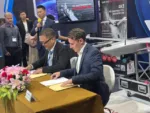Firehawk Aerospace has successfully completed a series of static fire tests using 3D-printed solid rocket propellants tailored for the launch motors of FGM-148 Javelin and FIM-92 Stinger missiles. Backed by the U.S. Army’s Combat Capabilities Development Command (DEVCOM), the tests mark a significant milestone in applying additive manufacturing to tactical missile energetics—potentially reducing costs, shortening production timelines, and enabling on-demand fabrication of critical munitions components.
Breakthrough in Additive Manufacturing for Tactical Missiles
The tests were conducted under a Phase II Small Business Innovation Research (SBIR) contract awarded to Firehawk Aerospace by the U.S. Army DEVCOM Aviation & Missile Center (AvMC). The program aims to evaluate whether Firehawk’s hybrid additive manufacturing approach can produce high-performance solid propellants suitable for use in existing tactical missile systems. The company’s proprietary method integrates traditional energetic materials with 3D printing techniques to create customized grain geometries that are difficult or impossible to achieve with conventional casting processes.
According to Firehawk CEO Will Edwards, the company’s approach allows unprecedented control over burn rates and thrust profiles through tailored internal grain architecture. “We’re not just printing inert shapes—we’re printing functional energetics,” Edwards told Defense News in an earlier interview. This capability could enable performance tuning of legacy systems like Javelin and Stinger without redesigning entire motors or warheads.
Focus on Javelin and Stinger Launch Motors
The recent test campaign focused on launch motor configurations representative of those used in the shoulder-launched FGM-148 Javelin anti-tank guided missile (ATGM) and the man-portable FIM-92 Stinger short-range air defense (SHORAD) system. These launch motors provide initial boost before handing off propulsion duties to main sustainers or flight motors.
Both missiles are critical components of U.S. and allied inventories—especially given their extensive use in Ukraine since early 2022. Their continued demand has stressed global production lines, making innovations that reduce lead times or increase flexibility highly attractive to acquisition planners.
By demonstrating compatibility with these two platforms’ motor envelopes and thrust requirements, Firehawk is positioning its technology as a drop-in enhancement rather than a full-system redesign—an approach more likely to gain rapid traction among program managers facing urgent replenishment needs.
Advantages Over Traditional Propellant Manufacturing
Conventional solid rocket motor production relies heavily on cast-cure processes that require long lead times, specialized tooling, strict environmental controls, and batch-based quality assurance procedures. In contrast, Firehawk’s hybrid additive process enables:
- Rapid prototyping: New grain geometries can be designed digitally and printed within days.
- Reduced waste: Material usage is optimized layer-by-layer rather than poured en masse.
- Improved safety: Energetic material handling is minimized due to localized deposition methods.
- Tunable performance: Burn profiles can be engineered via internal geometry rather than formulation changes alone.
This level of flexibility could also support distributed manufacturing concepts—for example, enabling forward-deployed depots or OEM partners to produce specific components closer to the point of need using digital files rather than physical supply chains.
Status of Testing and Next Steps
The static fire tests reportedly validated thrust levels consistent with operational requirements for both Javelin and Stinger launch motors. While detailed performance data remains classified or proprietary due to ITAR restrictions, DEVCOM officials have expressed satisfaction with initial results according to industry sources familiar with the program.
The next phase will likely involve environmental testing (e.g., thermal cycling, vibration), aging studies for long-term storage viability, and potentially live-fire integration trials under controlled conditions. If successful through Technology Readiness Level (TRL) 6–7 milestones within FY2025–26 timelines, follow-on contracts could support low-rate production pilots or integration into broader munition modernization efforts such as Joint All-Domain Command & Control (JADC2)-aligned logistics chains.
A Growing Ecosystem Around Printed Energetics
Firehawk is part of a growing cadre of U.S.-based firms exploring additive approaches to energetic materials—a field historically dominated by legacy defense primes due to safety regulations and capital barriers. Other players include X-Bow Systems (focused on small launch vehicles), Adranos Inc. (developing ALITEC aluminum-lithium propellants), and Lawrence Livermore National Laboratory (researching printed explosives).
The Department of Defense has increasingly signaled interest in these technologies as part of broader industrial base resilience strategies outlined in recent National Defense Industrial Strategy documents released by OSD(A&S). Additive energetics are viewed as key enablers for future munitions agility—particularly amid concerns about peer conflict pacing threats from China or Russia where rapid surge capacity may be decisive.
Implications for Future Missile Programs
If proven viable at scale, hybrid printed propellants could impact not only legacy systems but also next-generation designs such as Increment 5 versions of the JAGM (Joint Air-to-Ground Missile), future SHORAD interceptors under IFPC Inc 2-I programs like Enduring Shield/Gladiator-class missiles, or even loitering munitions requiring compact high-thrust boosters.
This technology also aligns with DOD goals around digital engineering—enabling simulation-driven design cycles where propulsion elements can be iterated virtually before being physically produced via additive means. That paradigm shift could compress development timelines from years into months while allowing modular upgrades across families of effectors sharing common propulsion architectures.









